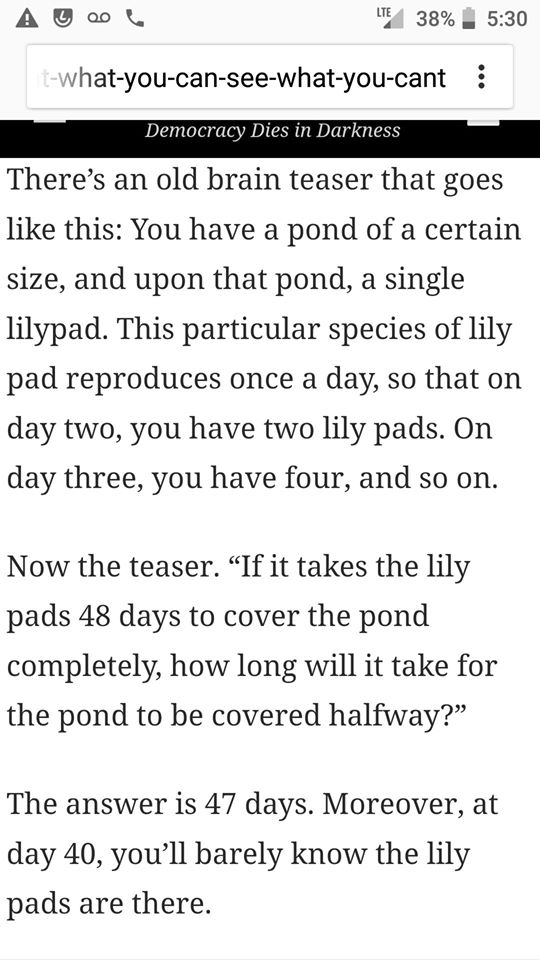Note: In 2020, I’m writing 52 blog posts, one per week, released Mondays or so…LIKE TODAY’s! This is Week 12‘s.
“It is not your fault, I know, but of those who put it in your head that you are exaggerating and even this testimony may seem just an exaggeration for those who are far from the epidemic, but please, listen to us” — intensive care physician Dr. Daniele Macchini, in translation from Humanitas Gavazzeni hospital in Bergamo, Italy, Friday 6th of March 2020. (Additional attribution information.)
Let’s say you’ve been living under a rock — or enslaved by time-consuming wage-work or an abusive chattel owner or months/years of lock up or an unhappy, exploitative marriage or other — and you exit that problem (at least partially) to simply arrive at another: everything’s suddenly different and everyone else has been talking, and continues to talk, about some sort of coronavirus deal. If you think that’s a joke, consider the number of people exiting various forms of confinement daily, not to mention the other scenarios in this paragraph.
Thankfully, you’re literate and you have about three hours on your hands, so what quality information should you read to catch yourself up on the scary COVID-19 disease caused by late 2019’s new version of coronavirus (a family of related viruses)?
Below are ten bullet points, plus a bonus eleventh, listing links to study up on, primarily — but not only — regarding the medical and practical sides of things, to help you catch up quickly on the pandemic. I’ve been reading about novel coronavirus (just a fancy way to say new coronavirus), since late February; that’s how I’m distilling down your reading to essential material. Required texts would differ regionally, of course, yet as a Seattleite previously from North Texas, I’m gearing the present post toward the United States. Seattle is also where the index case (aka patient zero) happened in this country, so compared with the rest of the US, Seattleites have had a head start on this new world. Without further ado:
1. On Friday 6 March 2020, Dr. Daniele Macchini, an intensive care unit physician at the Humanitas Gavazzeni hospital in Bergamo, Italy, wrote a Facebook post in Italian that the Italian newspaper Corriere della Sera (Bergamo edition) republished the next day, probably contributing to an English translation appearing on reddit Sunday 8 March 2020. To perceive clearly and quickly how serious all this is, read Dr. Daniele Macchini’s March 6, 2020 message in Italian or English. Epidemiologist Silvia Stringhini might have been the Italian-to-English translator (see this twitter thread of hers), but I’m not sure. I’ll try to update the translator info. Here’s a Wednesday 11 March 2020 Snopes piece providing attribution information for Dr. Macchini’s post. Here’s Dr. Macchini’s staffperson page at the Humanitas Gavazzeni hospital.
2. On Wednesday 11 March 2020, Dr. Tedros, the director general of the World Health Organization (WHO), an agency of the United Nations, announced, after the agency had been tracking the disease from the start, that WHO made the assessment that day that COVID-19 is a global pandemic. Though definitions of “pandemic” vary, change, and are debated (here’s the WHO’s from 2010), pandemic etymologically means all people, indicating plainly that all humans, including you and me and everyone else, are at risk of exposure. Dr. Tedros’s announcement of the disease’s global pandemic status came in his opening remarks during one of the frequent novel coronavirus press briefings WHO has been holding. His announcement is a document well worth reading, short and well written and well structured, and it should be looked back upon by future historians. Dr. Tedros called for immediate intelligent action everywhere, what his announcement terms a “whole-of-government, whole-of-society approach” planetwide. Also, Dr. Tedros said this is the first pandemic in history that, in his judgment as WHO director general, can be suppressed and controlled, i.e. by humans acting knowledgeably (I presume he’d say this is because of the Internet/global communications). Below, the full 59-minute video of the Wednesday 11 March 2020 press briefing. Dr. Tedros’ opening remarks are from 1 minute to 9.5 minutes.
3. Understand four reasons why it matters that this coronavirus is new/novel. Coronavirus is a family of similar/related viruses. It’s important to emphasize that this brand new version from late 2019 is a new coronavirus, or meaning the same thing, a novel coronavirus, because, as Dr. Francis Riedo, an infectious disease and travel medicine expert from Seattle’s EvergreenHealth healthcare system, explained during a Saturday 29 February 2020 Washington state Department of Health press conference, a) No one has immunity to it yet, b) No vaccine for it exists yet, and c) No treatment agent targeted specifically at it exists yet. I would add d) Researchers, scientists, and similar still do not have enough information about it. A-D of course exclude unusual and strange possible situations such as personalized medicine for the powerful. If anyone can forward me the raw video for that press conference with Dr. Francis Riedo, perhaps at C-SPAN, I’ll add it here and credit your name/pseudonym as you specify. Or I’ll do it myself later.
4. Understand exponential growth. Addition and exponentiation are both arithmetic operations. Here’s an addition example: 3 + 3 + 3 + 3 = 12. Here’s an exponentiation example: 34 = 3 × 3 × 3 × 3 = 81. That exponentiation is 3 times itself four times. It depends, but disease spread can often be more exponential than straightforward addition. Exponential because each infected person, especially prior to becoming incapacitated (but possibly even then), can infect many people, not just another single person. This Tuesday 10 March 2020 Washington Post article explains it quite well: “When coronavirus is growing exponentially, everything looks fine until it doesn’t.” Two screenshots excerpting that WaPo article:


This Friday 13 March 2020 article at USA Today explains what exponential growth means in terms of overwhelmed hospitals running out of beds in the United States: “A USA TODAY analysis shows there could be six seriously ill patients for every existing US hospital bed. No state is prepared.”
On Monday 23 March 2020, CNN journalist Ryan Struyk tweeted CNN’s figures for the United States, the total number of confirmed COVID-19 cases across the country for each day in March.
5. Here’s a practical, comprehensive guide to novel coronavirus and the disease it causes, COVID-19. This all-in-one coronavirus guide, started Sunday 8 March 2020 and updated daily, is by Ars Technica (Latin: the art of technology), a web magazine that’s been around for more than two decades in various incarnations. Condé Nast currently owns it (they also own Wired, The New Yorker, and plenty of others). If you spend an hour slowly and carefully working your way through that guide, you’ll be in pretty decent shape in terms of catching up. Other guides include this collaborative one out of Berlin, by a hacker and an artist, with input for healthcare professionals. This document/guide for COVID-19 mutual aid and advocacy resources across the United States might also be useful. If you have any other really excellent guides, please put them in the comments to this post or email them to me at DAL@RISEUP.NET.
6. Here’s the COVID-19 advice for the public section on the World Health Organization website. Study that material thoroughly. And better yet, start studying the COVID-19 section entire on the WHO’s website. It explains, among other things, that people of all ages, regardless of their other medical conditions or lack thereof, can become infected with COVID-19. All ages can die from it, again regardless of their other medical conditions or lack thereof (see also Thursday 19 March 2020 Bloomberg article). While a Monday 23 March 2020 WHO situation report says “For most people, COVID-19 infection will cause mild illness however, it can make some people very ill and, in some people, it can be fatal,” with the sheer quantity of “some people” — hundreds of thousands (or more) who will quite possibly become infected (hopefully not) — that means already overwhelmed hospital systems all over the planet will be in even more dangerous shape, especially countries without widespread access to healthcare such as the United States. Finally, it helps to understand the World Health Organization’s web address: https://who.int. WHO obviously stands for World Health Organization, but .INT is a sponsored top level domain that many in the United States might not be familiar with. It means international.
7. Understand soap and hand sanitizer. “Toilet soap” is the term for that category of soap everyday people are typically familiar with, such as in domestic cleaning or bathroom settings, as opposed to say industrial thickening soaps outside the realm of common experience. It depends, but regarding novel coronavirus, toilet soap may generally be more reliable than hand sanitizer (alcohol-based hand rub); however, hand sanitizer might be helpful for settings where people can’t access toilet soap: paid-workers taking hand sanitizer briefly out of their purses on public transit, for instance, or to replace toilet soap when people are at risk for certain skin reactions, including the hand dermatitis health care workers can get (and get fired for in some places) after years and years of washing their hands a zillion times on the job daily — that’s one reason why health care workers in specialized settings are often using alcohol-based hand rubs (hand sanitizer). Hand sanitizer may also be better for those directly caring for patients. On a daily ordinary human level, use regular toilet soap such as bar soap. The corporate bar soap, including Dial products, is marketed as antibacterial. But a virus causes COVID-19; thus, antibacterial doesn’t help with coronavirus specifically (viruses and bacteria are two completely different enemies/pathogens). Further, even the US Federal Death Agency, I mean the US Food and Drug Administration, wrote for consumers in May 2019 that there’s not sufficient scientific evidence to say antibacterial soap is any extra helpful against bacteria/generally, and they also wrote it (well, soap with the ingredient triclosan) may even be harmful, and not just because of antibiotic resistance. Prior to this pandemic, I used plain ol’ Dr. Bronner’s bar soap. A subcategory of “toilet soap” is “Castile soap,” Castile referring to a historical region in Spain, but meaning in practical terms the soap is based on olive oil. For toilet soaps to work against viruses (remember, not talking about antibacterial or antibiotic), you want them to be surfactants (short for Surface Active Agents) containing amphiphiles. Instead of trying to kill all the pathogens, the point of bar soap is more to escort the viruses down the drain. That part, and the part about amphiphiles and surfactants, I don’t understand fully, but suffice to say, Castile soap — or at least Dr. Bronner’s bar soap — is a surfactant with amphiphiles, so I feel comfortable enough to continue using it during this pandemic. Finally, the good information about handwashing for 20-30+ seconds, minding to clean each finger and cut your nails etc., is getting newly amplified due to this pandemic, yay! You’ll want to wash your hands like that regularly with soap and water. The soap details, and the soap vs. hand sanitizer debate, may be a lot more complicated than this (there are even studies about what to do, when washing your hands, with the ring or wristwatch you typically wear), but my bullet point write-up is a bit of a rush job. Here are resources: 270-page WHO report from 2009 about guidelines on hand hygiene in health care (may not apply to everyday folks); 7-page 2009 WHO brochure for those directly involved in patient care; Lisa Bronner of the Bronner family, consumer education / advertising, especially this post; under-5-minutes video, by TV personality and chef Alton Brown; US Centers for Disease Control and Prevention handwashing section; 13 March 2020 New York Times article praising toilet soap; World Health Organization handwashing post for World Water Day 2020. This research/writing should be continued further and may change as more is learned especially about novel coronavirus. I receive nada from Dr. Bronner’s and the Bronner family, I just like their stuff and frequently buy it myself.
8. Keep track of worldwide statistics using the following dashboards, but understand their limitations. Online dashboards give statistics for COVID-19 in different countries and their provinces, statistics such as number of confirmed cases, number of tests performed, number of deaths (often wrong since complications/comorbidities matter in determining what causes a death), and number of people recovered. However, there are lots of undetected cases, whether asymptomatic, mildly symptomatic, or very symptomatic and not counted. Asymptomatic (no symptoms) or mildly symptomatic (symptoms so mild they might not even be noticed) individuals can still be infected and transmit their infection to other people. Since the dashboards don’t track asymptomatic or mildly symptomatic cases, the true scale of the problem is bigger than the dashboards suggest. Further, some countries including the United States are not testing sufficently, and public health experts anywhere would presumably like to run more tests if possible. So, that means there are more people who are very sick and would count as confirmed cases if only tests were available enough — another reason the true scale of the pandemic is worse than the dashboards suggest. Finally, confinement facilities such as prisons, pretrial jails, psychiatric wards, detention camps, and others have a track record of not counting people accurately, to say the least (lockup facilities are targets for human traffickers), so that’s yet a third reason why already grim dashboards are not as grim as the full reality. On Wednesday 22 January 2020, the Johns Hopkins Center for Systems Science and Engineering first publicly shared their dashboard (which has a frequently asked questions and an article in The Lancet). A version of the John Hopkins dashboard, at Esri/Environmental Systems Research Institute’s ArcGIS geographic information system website, might be easier to use. I also very much like https://nCoV2019.live/data, created around Wednesday 25 December 2019 by Avi Schiffmann, a high schooler near Seattle. All three of those pull data from authoritative sources and refresh very frequently. Here’s one for Canada by PhD epidemiology candidates @JPSoucy and @ishaberry2 at the University of Toronto’s public health school, with the COVID-19 Canada Open Data Working Group curating data. There’s another, very official government dashboard for Canada, but I lost track of the URL. If you have it, please post it to the comments on this post or email it to me: DAL@RISEUP.NET. Here’s global and regional COVID-19 data from the WorldOMeters.Info website, its sources listed at the bottom of its webpage. Finally, the World Health Organization’s great COVID-19 global dashboard.
9. As this Saturday 14 March 2020 reddit post suggests, and as the World Health Organization is changing to, don’t say “social distancing,” say “physical distancing.” As I put it: Humans are unchangeably social animals, so social distancing kills us / drives us extinct. Physical distancing is accurate and encourages people to keep interacting socially, checking on each other, talking via video or email or phone call, etc. If you’re afraid of becoming unpopular as a result of saying something unusual, namely physical distancing, nobody ain’t got no time for that lifestyle anymore. As George Orwell, Heather Marsh, Philip K. Dick, and plenty of others have said over and over, language is so powerful as to be coercive (even if the effect is sometimes only short lived). Words matter. On Friday 20 March 2020, at the daily press briefing on COVID-19, Dr. Kerkhove said the World Health Organization is changing from “social distancing” to “physical distancing” (video, see 17:40 to 18:40).
10. Review quality scientific literature or other medical expert information. If you recover from COVID-19, can you get re-infected with it later, or do you develop immunity? Very likely you develop immunity; still uncertain. A Thursday 27 February 2020 Reuters report said a Japanese tour bus guide got re-infected after recovering, but that report, a Friday 28 February 2020 Wired piece raised questions about the next day. The Guardian on Monday 16 March 2020 reported experts say the possibility of re-infection after recovery is “unlikely”, though more research is needed to be sure.
Then we have this 5.5-minute video, embedded below, by Science/Business Insider, uploaded to youtube by them Wednesday 18 March 2020. The short video uses authoritative sources, including the World Health Organization, to explain what coronavirus symptoms are like day by day. Very highly recommended:
Regarding the gastrointestinal (GI) system, two peer-reviewed medical studies about novel coronavirus in the fairly high impact scientific journal Gastroenterology, authored by different sets of Chinese doctors, are worth reading: 6-page PDF from Wednesday 26 February 2020 and 15-page PDF from Thursday 27 February 2020. By now you’ve learned the new coronavirus is spread by droplets from sneezes and coughs, and even droplets from talking and heavy breathing, and that the most common symptom is fever, with the second most common symptom being a dry cough, ANY OR ALL OF WHICH CAN THEN TURN INTO RESPIRATORY FAILURE AS FOR THIS MAN IN HIS MID THIRTIES, Clement Chow, an assistant professor of genetics at the University of Utah.
Basically had a low grade fever for a few days then a bad cough, that turned into respiratory failure. I came in and they had to put me on high flow oxygen (3 times normal)…hence ICU
— Clement Chow (@ClementYChow) March 15, 2020
However, the Gastroenterology studies say the disease is also spread by the oral-fecal route (e.g., I assume, dirty diapers, oral sex, et cetera). A Wednesday 4 March 2020 research letter to the Journal of the American Medical Association disagrees, but does not cite the Gastroenterology studies. Though I’m not an expert, I say take the Gastroenteology studies extremely seriously and keep an eye on this/related research. The Gastroenteology studies also say COVID-19 can cause mild to moderate liver damage, and that some infected populations have shown less common GI symptoms — namely diarrhea, nausea, vomiting and abdominal discomfort — prior to the onset of the more well known respiratory symptoms. This all may change as further research is done, so keep an eye on this sort of thing and learn to read scientific/medical material. Yet also keep in mind the 2015 piece by Richard Horton, editor-in-chief of The Lancet, one of the world’s most prestigious medical journals, a piece that includes this:
Would you like solutions to that massive worldwide problem? Here are solutions to that massive worldwide problem: “A societal singularity” by Heather Marsh and her GetGee framework for a collaborative global data commons for public information. I’ll try to write knowledge-bridging posts to connect that material of hers to COVID-19 soon.‘A lot of what is published is incorrect.’ I’m not allowed to say who made this remark because we were asked to observe Chatham House rules. We were also asked not to take photographs of slides. Those who worked for government agencies pleaded that their comments especially remain unquoted […] The case against science is straightforward: much of the scientific literature, perhaps half, may simply be untrue. Afflicted by studies with small sample sizes, tiny effects, invalid exploratory analyses, and flagrant conflicts of interest, together with an obsession for pursuing fashionable trends of dubious importance, science has taken a turn towards darkness. As one participant put it, ‘poor methods get results’.
The above ten bullet points leave a lot out, including political and economic material, such as international borders closing for whatever duration including the US – Canada border, but there’s enough to keep many readers busy for a while.
Bonus: The final eleventh bullet point, optimistic material, which comes in two parts. First, the 14-minute Friday 13 March 2020 Democracy Now! video interview with 17-year-old Avi Schiffmann, the creator of the https://ncov2019.live/data global dashboard, who’s been programming since he was seven and says “You can learn anything online.” His site has been visited by 35 million people and counting. Avi Schiffmann’s next project is a COVID-19 vaccine tracker to keep tabs on the progress clinical trials. The transcript is here and the video is embedded below.
Second, this Monday 16 March 2020 Common Dreams article collects short videos, mostly social media posts, of physically distancing people singing, chanting, applauding with each other across balconies during covid19 pandemic. Includes Italy, the city of Wuhan in China, Lebanon, and Spain. To finish this blog post, I’ll embed items from the Common Dreams article below.


This blog post, Bullet points: HOWTO catch up on coronavirus fast if you’ve been living under a rock (or enslaved), by Douglas Lucas, is licensed under a Creative Commons Attribution-NonCommercial-ShareAlike 4.0 International License (human-readable summary of license). The license is based on a work at this URL: https://douglaslucas.com/blog/2020/03/23/howto-catch-up-coronavirus-fast-underrock-enslaved/ You can view the full license (the legal code aka the legalese) here. For learning more about Creative Commons, I suggest this article and the Creative Commons Frequently Asked Questions. Seeking permissions beyond the scope of this license, or want to correspond with me about this post otherwise? Please email me: dal@riseup.net.






 Twitter:
Twitter:
Join the conversation